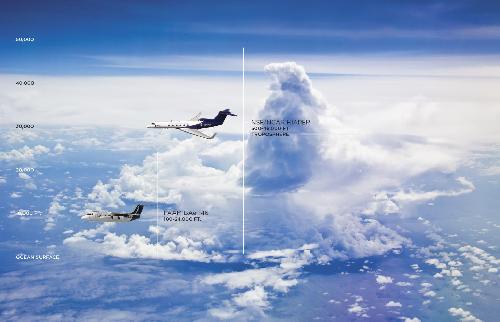As decision makers from around the world congregated in Paris to prepare a global climate agreement at the 21st Conference of the Parties (COP21), many discussions focused on how to reduce greenhouse gases, including ozone.
While efforts to limit ozone precursor emissions tend to focus on industrial activities and fossil fuel combustion in the United States and China, a new study suggests that future regulations may need to address the burning of forests and vegetation. The study, which was published online January 13, 2016 in the journal Nature Communications, indicates that these types of "biomass burning" may play a larger role in climate change than previously realized.
Based on observations from two aircraft missions, satellite data and a variety of models, an international research team showed that fires burning in tropical Africa and Southeast Asia caused pockets of high ozone and low water in the lower atmosphere above Guam--a remote island in the Pacific Ocean 1,700 miles east of Taiwan.

"We were very surprised to find high concentrations of ozone and chemicals that we know are only emitted by fires in the air around Guam," said the study's lead author Daniel Anderson, a graduate student in the University of Maryland Department of Atmospheric and Oceanic Science. "We didn't make specific flights to target high-ozone areas--they were so omnipresent that no matter where we flew, we found them."
For the study, two research planes on complementary missions flew over Guam measuring the levels of dozens of chemicals in the atmosphere in January and February 2014. One aircraft flew up to 24,000 feet above the ocean surface during the U.K. Natural Environment Research Council's Coordinated Airborne Studies in the Tropics (CAST) mission. The other flew up to 48,000 feet above the ocean surface during the CONvective Transport of Active Species in the Tropics (CONTRAST) mission.
"International collaboration is essential for studying global environmental issues these days," said CAST Principal Investigator Neil Harris of the University of Cambridge Department of Chemistry. "This U.S./U.K.-led campaign over the western Pacific was the first of its kind in this region and collected a unique data set. The measurements are now starting to produce insight into how the composition of the remote tropical atmosphere is affected by human activities occurring nearly halfway around the world."
Researchers examined 17 CAST and 11 CONTRAST flights and compiled over 3,000 samples from high-ozone, low-water air parcels for the study. In the samples, the team detected high concentrations of chemicals associated with biomass burning--hydrogen cyanide, acetonitrile, benzene and ethyne.
"Hydrogen cyanide and acetonitrile were the smoking guns because they are emitted almost exclusively by biomass burning. High levels of the other chemicals simply added further weight to the findings," said study co-author Julie Nicely, a graduate student in the UMD Department of Chemistry and Biochemistry.
Next, the researchers traced the polluted air parcels backward 10 days, using the National Oceanic and Atmospheric Administration (NOAA) Hybrid Single Particle Lagrangian Integrated Trajectory (HYSPLIT) model and precipitation data, to determine where they came from. Overlaying fire data from NASA's moderate resolution imaging spectroradiometer (MODIS) onboard the Terra satellite, the researchers connected nearly all of the high-ozone, low-water structures to tropical regions with active biomass burning in tropical Africa and Southeast Asia.
"The investigation utilized a variety of models, including the NCAR CAM-Chem model to forecast and later analyze chemical and dynamical conditions near Guam, as well as satellite data from numerous instruments that augmented the interpretation of the aircraft observations," said study co-author Douglas Kinnison, a project scientist at the University Corporation for Atmospheric Research.
In the paper, the researchers also offer a new explanation for the dry nature of the polluted air parcels.
"Our results challenge the explanation atmospheric scientists commonly offer for pockets of high ozone and low water: that these zones result from the air having descended from the stratosphere where air is colder and dryer than elsewhere," said UMD Professor Ross Salawitch, the study's senior author and principal investigator of CONTRAST. Salawitch holds joint appointments in the university's Department of Atmospheric and Oceanic Science, Department of Chemistry and Biochemistry, and Earth System Science Interdisciplinary Center.
"We know that the polluted air did not mix with air in the stratosphere to dry out because we found combined elevated levels of carbon monoxide, nitric oxide and ozone in our air samples, but air in the higher stratosphere does not contain much naturally occurring carbon monoxide," said Anderson.
The researchers found that the polluted air that reached Guam never entered the stratosphere and instead simply dried out during its descent within the lower atmosphere. While textbooks show air moving upward in the tropics, according to Salawitch, this represents the net motion of air. Because this upward motion happens mostly within small storm systems, it must be balanced by air slowly descending, such as with these polluted parcels released from fires.
Based on the results of this study, global climate models may need to be reassessed to include and correctly represent the impacts of biomass burning, deforestation and reforestation, according to Salawitch. Also, future studies such as NASA's upcoming Atmospheric Tomography Mission will add to the data collected by CAST and CONTRAST to help obtain a clearer picture of our changing environment.




Comments